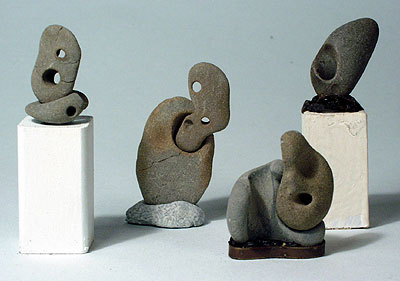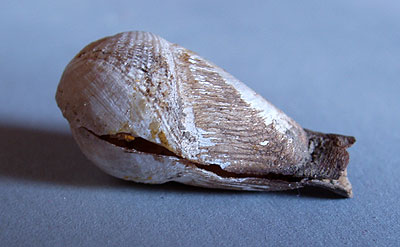

Recent posts here on Andy Goldsworthy and Hubert Duprat have covered collaborations between nature and people to make art. This is a common theme in Zymoglyphic culture, where the motto for artists is "Let nature do the detail work." The sculptures shown here are a collaboration among a boring clam (boring in that it drills holes, not that it is uninteresting), the sea, and a human eye and hand to select and arrange the results. The clam in question (a specimen from the museums's collection is shown here) is also known as a piddock. It is more torpedo-shaped than clam-shaped and has the ability to rasp its way into rock using the ridges on its shell and a rotating motion. It uses the holes it creates for protection. When the rock is broken up by erosion (often aided by the weakening of the rock by the clam holes themselves), the resulting fragments are worn smooth by wave action and cast up on the shore. The results often bear an uncanny resemblance to that archetype of modernist sculpture, the 3-dimensional free-form blob with one or more holes in it. These are prized by Zymoglyphic collectors. Some the museum's specimens of this type of natural art are featured in the Shoebox Art Galleries 1 and 2. Two of those sculptures have been gathered here for the group portrait; the rest are making their internet debut.
These sculptures can be seen as Modern Age descendants of the miniature viewing stones that were so popular during the Zymoglyphic region's Era of Oriental Influence. The boring clams themselves have their place alongside the Xenophora in the Zymoglyphic pantheon of molluscan artists. The clams are seen as true "sculptors", rather than, like the Xenophora, assemblers of found objects.
No comments:
Post a Comment